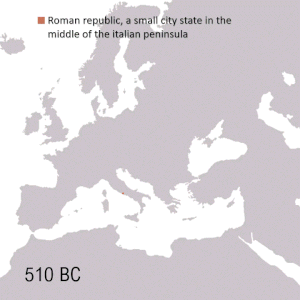틀:로마 제국 표
| 로마 제국 | ||||
|---|---|---|---|---|
| 라틴어: Senatus Populusque Romanus Imperium Romanum[a] 코이네 그리스어: Βασιλεία τῶν Ῥωμαίων | ||||
| ||||
![트라야누스가 사망한 서기 117년 로마 제국 최대 규모 봉신들[2][b]](http://upload.wikimedia.org/wikipedia/commons/thumb/0/00/Roman_Empire_Trajan_117AD.png/300px-Roman_Empire_Trajan_117AD.png) | ||||
 도시 국가 로마의 부상에서 서로마 제국의 몰락까지 로마 영토의 진화 | ||||
| 수도 | ||||
| 정치 | ||||
| 정치체제 | 준선거적 전제군주제 | |||
| 황제 기원전 27년 ~ 서기 14년 98년 ~ 117년 117년 ~ 138년 306년 ~ 337년 379년 ~ 395년 | 아우구스투스(초대) 트라야누스 하드리아누스 콘스탄티누스 테오도시우스(말대) | |||
| 입법부 | 제국 원로원 | |||
| 역사 | ||||
| • 악티움 해전 | 기원전 31년 | |||
| • 아우구스투스 칭호 시작 | 기원전 27년 | |||
| • 5현제 치세 | 96년 ~ 180년 | |||
| • 디오클레티아누스의 제국 분할 | 285년 | |||
| • 콘스탄티노폴리스 천도 | 330년 | |||
| • 제국의 동서방 행정분할 | 395년 | |||
| • 제국의 서방 영토 상실 | 476년 | |||
| • 멸망 | 1453년 | |||
| 지리 | ||||
| 면적 | 5,000,000 km2 | |||
| 인문 | ||||
| 공용어 | 라틴어 | |||
| 데모님 | 로마인 | |||
| 인구 | ||||
| 117년 어림 | 88,000,000명 | |||
| 인구 밀도 | 17.6명/km2 | |||
| 경제 | ||||
| 통화 | 콰드란스 세미스 아시스 퀴나리우스 세스테르티우스 데나리우스 아우레우스 솔리두스 | |||
| 종교 | ||||
| 종교 | ||||
각주[편집]
- ↑ Morley, Neville (2010). 《The Roman Empire: Roots of Imperialism》. ISBN 978-0-7453-2870-6.; Diamond, Jared (2011). 《Collapse: How Societies Choose to Fail or Succeed》 Revis판. 13쪽. ISBN 978-1-101-50200-6.
- ↑ Bennett (1997).
- ↑ 가 나 《Ancient Rome: The Definitive Visual History》 (영어). Dorling Kindersley Limited. 2023. 276쪽. ISBN 978-0-241-63575-9.
- ↑ Classen, Albrecht (2010). 〈The changing shape of Europe〉. 《Handbook of Medieval Studies: Terms – Methods – Trends》 (영어). Walter de Gruyter. ISBN 978-3-11-021558-8.
Constantine the Great transferred the capital of the Roman Empire from Rome to the newly-founded city of Constantinople
- ↑ Price, Jonathan J.; Finkelberg, Margalit; Shahar, Yuval (2022). 《Rome: An Empire of Many Nations》 (영어). Cambridge University Press. 19쪽. ISBN 978-1-009-25622-3.
the capital of the Empire was transferred from Rome to Constantinople in the fourth century
- ↑ Erdkamp, Paul (2013). 《The Cambridge Companion to Ancient Rome》 (영어). Cambridge University Press. 202쪽. ISBN 978-0-521-89629-0.
Constantine sounded the death knell for Rome as a vital political centre with the dedication of his new imperial capital at Constantinople
- ↑ Bjornlie, M. Shane (2013). 《Politics and Tradition Between Rome, Ravenna and Constantinople: A Study of Cassiodorus and the Variae, 527–554》 (영어). Cambridge University Press. 41쪽. ISBN 978-1-107-02840-1.
As a new capital, Constantinople provided a stage for imperial prestige that did not depend on association with the traditions of the senatorial establishment at Rome
- ↑ Coffler, Gail H. (2004). 《Melville's Allusions to Religion: A Comprehensive Index and Glossary: A Comprehensive Index and Glossary》 (영어). ABC-CLIO. 181쪽. ISBN 978-0-313-07270-3.
It became Constantinople, capital of the entire Roman Empire
- ↑ Maxwell, Kathleen (2016). 〈Art and Diplomacy in Late Thirteenth-century Constantinople: Paris 54 and the Union of Churches〉. 《Between Constantinople and Rome: An Illuminated Byzantine Gospel Book (Paris gr. 54) and the Union of Churches》 (영어). Routledge. ISBN 978-1-351-95584-3.
Constantine the Great, the emperor who moved the capital of the Roman Empire from Rome to Constantinople
- ↑ Grig, Lucy; Kelly, Gavin (2012). 《Two Romes: Rome and Constantinople in Late Antiquity》 (영어). Oxford University Press. 237쪽. ISBN 978-0-19-992118-8.
- ↑ Loewenstein, K. (2012). 《The Governance of ROME》 (영어). Springer. 443쪽. ISBN 978-94-010-2400-6.
- ↑ Harris, Jonathan (2009). 《Constantinople: Capital of Byzantium》 (영어). A&C Black. 31쪽. ISBN 978-0-8264-3086-1.
- ↑ Treadgold (1997), 734쪽.
- ↑ Tricht, Filip Van (2011). 《The Latin Renovatio of Byzantium: The Empire of Constantinople (1204–1228)》 (영어). Brill. 61–82쪽. ISBN 978-9004203235.
- ↑ 인용 오류:
<ref>태그가 잘못되었습니다;fnother라는 이름을 가진 주석에 텍스트가 없습니다 - ↑ Fig. 1. Regions east of the Euphrates river were held only in the years 116–117.
- ↑ In 286, Emperor Diocletian divided the Roman Empire into two administrative units–East and West–an arrangement that periodically returned until the two halves were permanently divided in 395.[3] Although the halves were independent in practice, the Romans continued to consider the Roman Empire to be a single undivided state with two co-equal emperors until the fall of the western half in 476/480.[3] Although emperors at times governed from other cities (notably Mediolanum and Ravenna in the West and Nicomedia in the East), Rome remained the de jure capital of the entire Roman Empire until Emperor Constantine I transferred the capital to Constantinople ("New Rome") in 330, henceforth the new capital of the entire empire.[4][5][6][7][8][9] For a time, mostly over the course of the later decades of the fourth century, Rome continued to hold greater symbolic status on account of its greater antiquity as imperial capital.[10] From at least 361 onwards, senators belonging to the new senate in Constantinople enjoyed the same status and privileges as senators of the Roman Senate, to which the new senate was largely identical.[11] By 450, Constantinople was much grander in size and adornment than Rome and unquestionably senior in status.[12]
- ↑ In 1204, the crusaders of the Fourth Crusade captured Constantinople and established the Latin Empire. The city remained under foreign rule until 1261, when it was captured by the Empire of Nicaea (a Byzantine/Roman successor state). Nicaea is usually considered the "legitimate" continuation of the Roman Empire during the "interregnum" 1204–1261 (over its rivals in Trebizond and Thessalonica) since it managed to retake Constantinople.[13] Whether there was an interregnum at all is debatable given that the crusaders envisioned the Latin Empire to be the same empire as its predecessor (and not a new state).[14]


